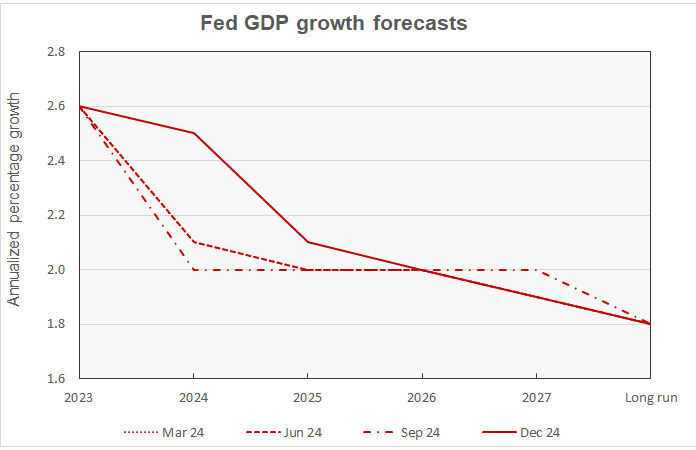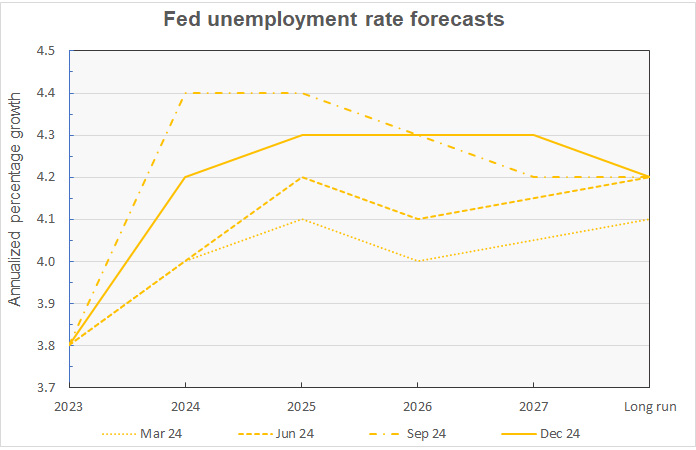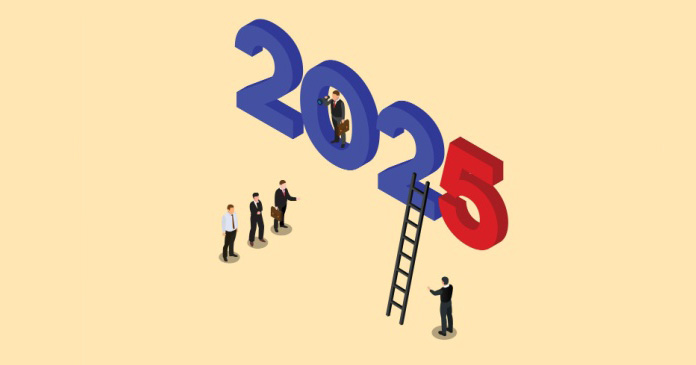The economic projections released by the Federal Open Market Committee (FOMC) after this week’s meeting indicate that they will be keeping interest rates higher for longer than they suggested in other recent projections. This is especially true when compared to their projections after September’s meeting. Their current projections indicate that they will deliver only two ¼ point rate cuts by the end of next year, down from the four they projected after their pre-election meeting in September.
The FOMC meets 8 times per year but only releases an economic forecast at 4 of the meetings. The Fed forecast presents estimates for economic metrics for December of each year through 2027 and a “longer run” forecast which reflects their view of the equilibrium state of the economy. The consensus Fed forecast is developed by the combining the forecasts of 19 economists. Each of the economists assumes that the Fed will follow “appropriate” monetary policy during the term of the forecast, although their individual ideas of what that policy is may vary.
Interest rates higher for longer
As expected, the Fed delivered a ¼ point rate cut after their recent meeting. However, they raised their projections for the Fed Funds interest rate over the rest of their forecast horizon. Their interest rate projections for the ends of both 2025 and 2026 were raised by a half point each compared to September’s projection. Their projection for the Fed Funds rate at the end of 2027 was raised by a quarter point.
The projection for the long-run interest rate was also raised again in the current forecast, rising another 0.1 percentage point to 3.0 percent. This marks 4 straight projections where they have raised their forecast for the long-run, or equilibrium, interest rate. This is the rate that they estimate will result in the economy best achieving the Fed’s twin mandate of inflation at 2.0 percent and maximum employment. In every economic projection released in 2021 through 2023 except for one, the Fed had estimated the equilibrium rate to be 2.5 percent. Raising this rate means that the Fed now believes that higher interest rates will be necessary to maintain the balance between maximizing employment and keeping inflation under control. This thinking may also be affecting their decision on what is the appropriate current interest rate.
A history of the forecasts for the Federal Funds rate is given in the first chart, below.

Inflation outlook darkens
The Federal Reserve’s preferred inflation measure is based on the Personal Consumption Expenditures (PCE) survey, rather than the more familiar Consumer Price Index (CPI). Compared to September’s forecast, the year-end reading for 2024 was raised 0.1 percentage points to 2.4 percent. The year-end inflation forecast for 2025 was raised 0.4 percentage points after being lowered 0.2 percentage points in September.
The projection for year-end inflation for 2025 is now 2.5 percent. The projection for year-end inflation for 2026 was raised 0.1 percentage point to 2.1 percent. The Fed does not expect to achieve its 2.0 percent inflation target until 2027.
Recent PCE inflation forecasts are shown in the next chart.

GDP growth projections for 2024 sharply higher
Fed’s median forecast for 2024 GDP growth also saw a major revision in December’s projection. It was revised 0.5 percentage points higher to 2.5 percent. Usually, revisions from forecast to forecast are not more than 0.2 percent. The higher GDP growth rate predicted for next year may give the Fed confidence that the economy has the strength to withstand the higher interest rates they are now expecting.
Recent Fed GDP forecasts are illustrated in the next chart, below.

Unemployment down from last forecast
The Fed forecasts that the year-end unemployment rate will be 4.2 percent in 2024, down 0.2 percentage points from September’s forecast. The 4.4 percent unemployment rate predicted for 2024 in the September forecast was part of the justification for the 0.5 percent target Fed Funds rate cut that month. The better unemployment outlook in the current forecast may explain the higher interest rate targets.
The unemployment rate forecast for year-end 2025 is unchanged from September’s forecast while the forecast for 2026 was revised 0.1 percentage point upward to 4.3 percent.
The history of the Fed’s recent unemployment rate forecasts is shown in the next chart.

The next updates to the Federal Reserve’s forecasts for the economy will come after the March 2025 FOMC meeting which concludes March 22.













